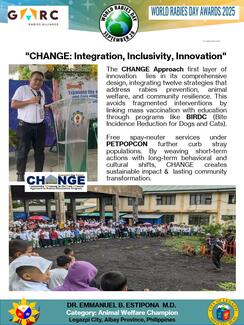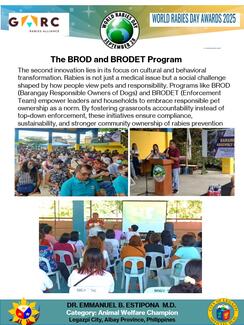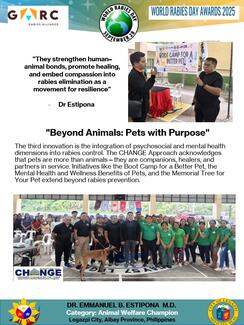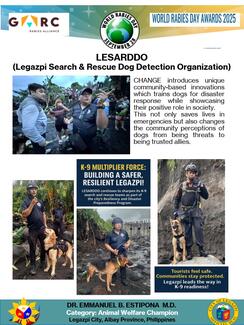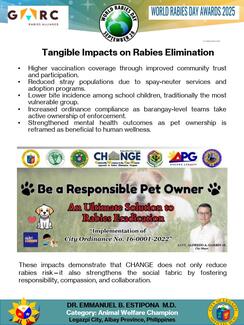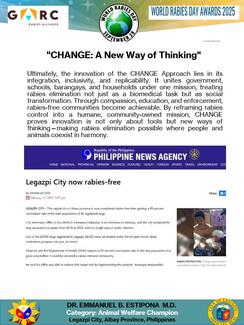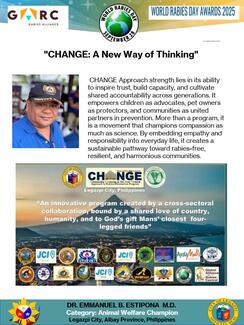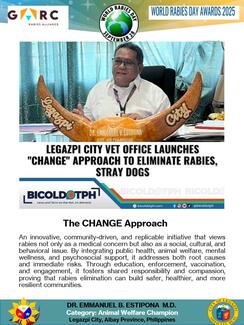
The CHANGE Approach is more than an anti-rabies campaign—it is an innovative movement that unites public health, animal welfare, and community development. Its impact is seen not just in reduced rabies cases but in healthier, more responsible, and more compassionate communities. By turning rabies elimination into a shared mission, CHANGE ensures that the fight against rabies is not only effective but also enduring.
Rabies has long been recognized as a preventable yet persistent public health threat, claiming lives despite decades of mass vaccination campaigns. The reality is that vaccination alone cannot solve the problem, because rabies is deeply rooted in cultural practices, behavioral gaps, and weak enforcement of existing laws.
This is where the CHANGE Approach (Community Harmony on the New General Approach to Rabies Elimination) stands out as a truly innovative model. Unlike conventional programs that focus narrowly on vaccines and stray control, the CHANGE Approach reshapes rabies elimination into a holistic, community-driven movement that addresses both the root causes and long-term sustainability of solutions.
The first layer of innovation lies in its comprehensive design. The CHANGE Approach integrates twelve interconnected strategies, each targeting a different dimension of rabies prevention, animal welfare, and community resilience. This prevents the common pitfall of fragmented interventions. For example, vaccination campaigns (Rabies Mass Vaccination) are paired with education programs like BIRDC (Bite Incidence Reduction for Dogs and Cats), ensuring that bite prevention is understood at the household and school levels. Meanwhile, free spay-neuter services through PETPOPCON reduce the future stray population, addressing the cycle of neglect and abandonment.
By weaving these strategies into one framework, CHANGE ensures that short-term gains are reinforced by long-term behavioral and cultural shifts. The second innovation is its emphasis on cultural and behavioral transformation. Rabies is not only a medical issue—it is a social challenge influenced by how people perceive pets and their responsibilities. Programs like BROD (Barangay Responsible Owners of Dogs) and BRODET (Barangay Responsible Owners of Dogs Enforcement Team) empower local leaders and households to internalize responsible pet ownership as a way of life. Unlike traditional enforcement, which often breeds resistance, BROD and BRODET create grassroots accountability, making communities active enforcers of their own safety.
This shift—from government-imposed rules to community-owned responsibility—is a breakthrough in ensuring compliance and sustainability. The third area of innovation is its integration of psychosocial and mental health dimensions into rabies control. The CHANGE Approach recognizes that pets are more than animals—they are companions, healers, and even partners in public service. Programs such as the Boot Camp for a Better Pet, the Mental Health and Wellness Benefits of Pets, and the Memorial Tree for Your Pet go beyond rabies prevention to nurture human–animal bonds, provide therapeutic benefits, and promote healing after loss. T
his humane and compassionate lens makes rabies elimination not just a health campaign, but also a movement for emotional well-being and social resilience. Furthermore, CHANGE introduces unique community-based innovations like the LESARDDO (Legazpi Search and Rescue Dog Detection Organization), which trains dogs for disaster response while showcasing their positive role in society. This not only saves lives in emergencies but also changes community perceptions of dogs from being threats to being trusted allies. The Dog Adoption Bonanza Program likewise turns abandoned dogs into rehabilitated, adoptable pets, proving that stray reduction can be achieved humanely and sustainably.
Ultimately, the innovation of the CHANGE Approach rests in its integration, inclusivity, and replicability. It unites government, schools, barangays, and households under one shared mission. It treats rabies elimination not just as a biomedical task but as a social transformation. And it demonstrates that through compassion, education, and enforcement, rabies-free communities are within reach.
By reframing rabies control into a holistic, humane, and community-owned mission, the CHANGE Approach proves that innovation is not just about new tools—it is about new ways of thinking. It is a model worthy of replication, showing the world that rabies elimination is possible when people and animals live together in harmony.
Event images
